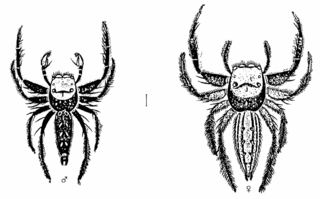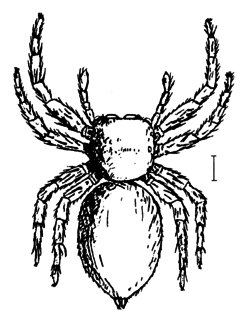
Myrmarachne is a genus of ant-mimicking jumping spiders that was first described by W. S. MacLeay in 1839. They are commonly called antmimicking spiders, but they are not the only spiders that have this attribute. The name is a combination of Ancient Greek μύρμηξ (myrmex), meaning "ant", and ἀράχνη (arachne), meaning "spider".

Bavia is a genus of jumping spiders.

Carrhotus is a genus of jumping spiders that was first described by Tamerlan Thorell in 1891. The name is derived from the Greek Κάῤῥωτος.

Epeus is a genus of the spider family Salticidae. They are often found on broad-leaved plants or shrubs of rain forest, or in gardens of Southeast Asia.
Ergane is a genus of jumping spiders that was first described by Ludwig Carl Christian Koch in 1881. Males of E. benjarei is 9 millimetres (0.35 in) long. The form of the pedipalp and the abdominal pattern suggest that Ergane is close to Chalcotropis. It is named after the goddess Athena, called Athena Ergane as the patron of craftsmen and artisans.
Maileus is a monotypic genus of jumping spiders containing the single species, Maileus fuscus. It was first described by G. Peckham & Elizabeth Peckham in 1907, and is only found on Borneo. It is closely related to the genus Microhasarius.

Mantius is a spider genus of the jumping spider family, Salticidae.
Microhasarius is a spider genus of the jumping spider family, Salticidae.
Ogdenia is a monotypic genus of jumping spiders containing the single species, Ogdenia mutilla. It was first described by George Peckham in 1907, and is only found on Borneo.

Pancorius is a genus of Asian jumping spiders that was first described by Eugène Louis Simon in 1902. They are similar to Hyllus.
Pristobaeus is a genus of jumping spiders that was first described by Eugène Louis Simon in 1902.

Telamonia is a genus of jumping spiders that was first described by Tamerlan Thorell in 1887. They are colorful spiders, with patterns that vary considerably between sexes and species. Two longitudinal stripes along the abdomen are common, and the carapace is often colored. They have a slender opisthosoma and long legs.
Vailimia is a genus of Asian jumping spiders that was first described by C. F. Kammerer in 2006. It was first described in 1907 from a single male about 6 millimetres (0.24 in) long. It was originally thought to be close to Harmochirus, but the male pedipalp, chelicera, and cephalothorax drawn by Proszynski in 1984, and information gained from later collected specimens indicates otherwise. Subsequently, three more species have been identified. It may be a synonym for Pancorius.

Viciria is a genus of jumping spiders that was first described by Tamerlan Thorell in 1877. The genus includes thirty-one accepted species.
Pseudamycus is a spider enus of the jumping spider family, Salticidae. The monotypic genus Taivala is thought to be closely related.

The Plexippini are a tribe of jumping spiders (Salticidae). They have also been treated as the subfamily Plexippinae. They are native to the Old World.
Emertonius is a genus of spiders in the jumping spider family Salticidae.
Parabathippus is a genus of Southeast Asian jumping spiders that was first described by J. X. Zhang & Wayne Paul Maddison in 2012.
Hermosa is a genus of spiders in the family Salticidae. It was first described in 1892 by George and Elizabeth Peckham. As of 2019, it contains 7 species.








